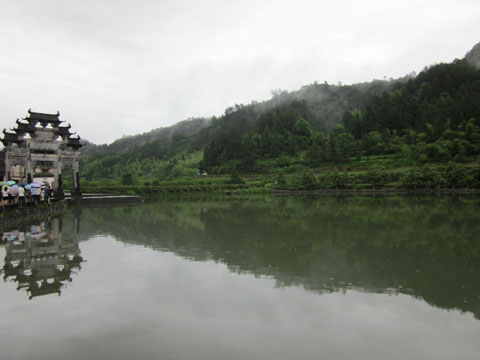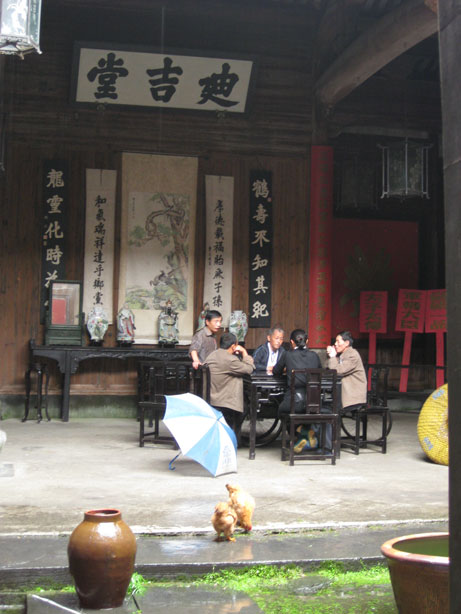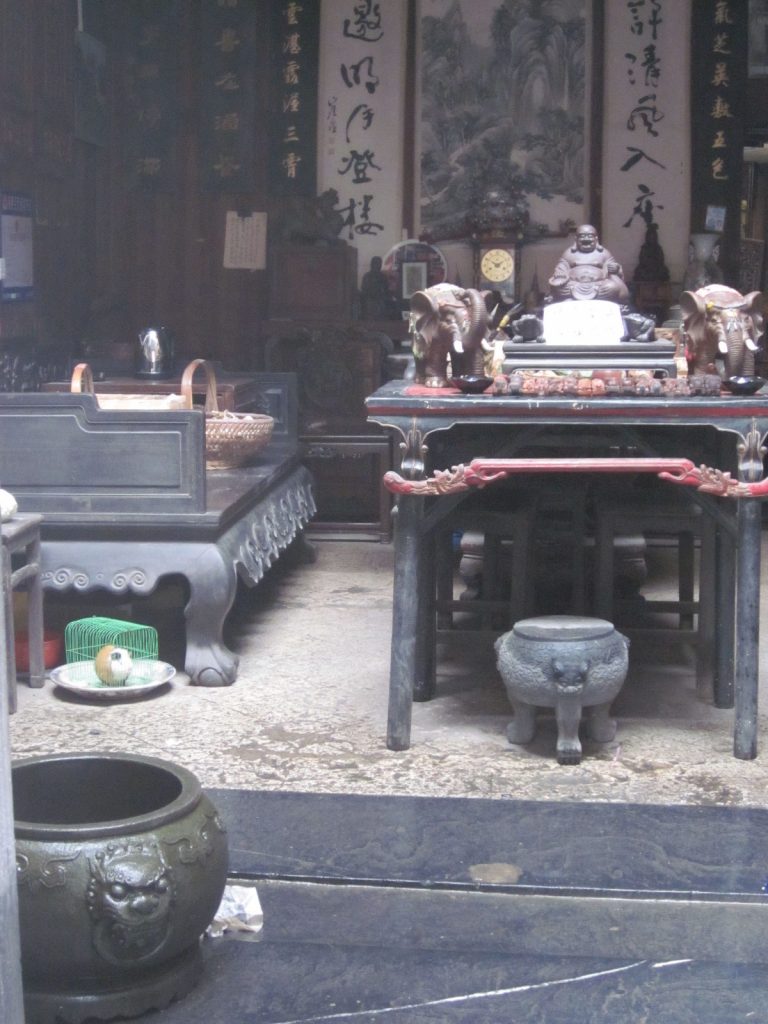EXT. YUAN COMPOUND – DAY
Security men and porters are loading wagons for a convoy. As they work, we see across the lake a lone horseman entering the village. One of the men recognizes him.
WORKER
Master Li is here!
ANGLE ON: Li Mu Bai, thirties, powerful and handsome.
In the background, old Aunt Wu, at the sight of Li Mu Bai, drops her parcels and runs excitedly into the building.
And thus begins the script for Crouching Tiger, Hidden Dragon. What the script is missing is a description of the scenery during that scene so let me fill it in for you. Chow Yun-Fat’s character (Master Li) is walking into a small, ancient village leading his horse. There is a stone bridge poetically arching over a river that leads to the entrance of the small village. He walks slowly across a stone causeway, the white buildings reflected in the still water surrounding him.
Crouching Tiger is actually one of the reasons that we are in China right now (I’ll explain more about that later) so I was very excited to learn it had been filmed in a village nearby Yellow Mountain. It’s not just any village mind you, but a place called Hongcun (hong-cwun), which is a UNESCO World Heritage Site in Anhui province. It is one of the nicest preserved ancient villages still in use today. Next to it is Xidi (she-dee), another UNESCO village. I knew we had to go, even if it was pissing rain if for nothing else to walk the streets of master Li.

Both villages are actually lived in, not just museums, but of course tourism is the main industry. We went on a Tuesday, in the middle of the week, in pouring rain, and our tour bus was filled. (We went with a Chinese tour group to save money. The guide only spoke Chinese but we left the group as soon as we entered each village and met them back at the bus at the pre-arranged time.)
Actually the colorful umbrellas and rain gear did add a nice splash of color on the dark, dreary day.

The village of Hongcun was founded in 1131 by a general and was quite a prosperous little place for while. It’s shaped like an Ox, with a hill as the head, two giant trees as horns, little streams as intestines, a small lake as the stomach and four bridges which represent 4 legs. But to be honest, we had no idea at the time. The streets are small, curvy and they’re directional signs make no sense. We tried looking for the ‘stomach’ lake, called Half-Moon Lake, but we’re unsuccessful. Another problem was the village didn’t have the best drainage and many of the small streets were flooded.
But it was still amazing, small and ancient. As we wandered we found ourselves completely alone many times. No tourists, no locals, just narrow winding alleys, old wooden doors, and chicken and cats running about. In fact, some of the streets were so narrow we had to tilt our umbrellas so it wouldn’t scrape the walls.
Xidi is close-by and again, is walled with a beautiful lake by the entrance and small streams running throughout (ancient plumbing that is still used today to wash clothes, clean vegetables and more). Xidi doesn’t have an official founding date, but it started getting built up around 1047 thanks to an influential family that had dealings with the emperors throughout the Ming and Qing dynasties.

Personally, I liked Xidi a little better than Hongcun, maybe just because it was smaller and less crowded (though a little more flooded). There were many pathways that led to doorways outside the wall, and surrounding the village was incredibly beautiful, lush green mountains.
In both villages there were many historic buildings that you were free to walk in and look about. In Hongcun inside every room was at least 2-3 little tables with elderly locals trying to sell you tchotchkes. But in Xidi the rooms were furnished but empty. It seemed as if the ancient owners had just stepped out for a minute and you were waiting for them to come back.
Well, I shouldn’t say all the rooms were empty, because that wasn’t entirely true. In one room we stumbled into what looked like a group of locals playing cards or something. They were seated around a big table, yelling, talking and having a good time while chickens walked around pecking at the ground. For a moment we thought we actually had walked into someone’s house. We took a few quick pics and left.

The rooms were vast, with 20-foot ceilings and stone floors. One part of the ceiling, close to the entrance, was open, to let in light and air. Beneath it was a stone platform and giant ceramic and stone urns for collecting and saving water. (I think. That’s what they were doing now.) Under the covered part were paintings, calligraphy and furniture. We have been to a number of ancient villages in China, but this felt the most “Chinese.” (Which, I guess, means it’s the style I have seen the most in movies.)

Anhui province is known for tea, and we saw it everywhere we went. There are three famous types here: Taiping Hou Kui (known as Monkey King tea), Huang Shan Mao Feng (a green tea), and Qimen black tea (also called keemun black tea, once an ingredient in English Breakfast teas). We saw little tea shops just about everywhere, but sadly were too wet to partake in a tasting. Next time.
This area isn’t usually at the top of anyone’s list when coming to China (hell, it’s a mere two hours away from us and it took us almost 2 years to visit) but it should be. It’s totally unique with some stunning scenery. And who knows, maybe you’ll even run into the spirit of Master Li.







this was a wonderful post… i will have to go visit this place..sometimes…. excellent photos.. but maybe i will go when it isnt raining so much….
Thanks! And yes, next time I will take the weather report a little more seriously. I mean, I even checked and knew it was going to rain, but thought…how bad could it be? Turns out pretty bad!